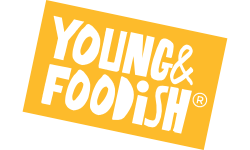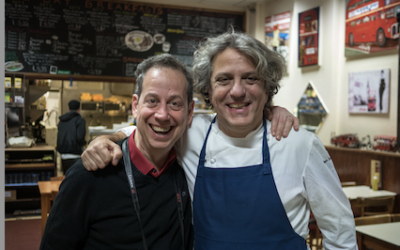 My recent visit to New York coincided with another bout of unease for Andy D’Amico, the chef/co-owner of 5 Napkin Burger as well as Nice Matin, the Mediterranean restaurant where he first introduced the drippy burger (pictured above) with an ensemble of melted Gruyère, caramelized onions and rosemary aïoli for which four napkins are not enough.
My recent visit to New York coincided with another bout of unease for Andy D’Amico, the chef/co-owner of 5 Napkin Burger as well as Nice Matin, the Mediterranean restaurant where he first introduced the drippy burger (pictured above) with an ensemble of melted Gruyère, caramelized onions and rosemary aïoli for which four napkins are not enough.
5 Napkin built its reputation as well as its growing fleet of burger brasseries – the fourth 5 Napkin opens in Boston in a month and a fifth in Miami Beach’s South Beach soon after – on chuck meat. Even so, the introspective D’Amico was thinking the unthinkable: chucking some of the chuck.
 D’Amico was restless. A chef with a passion for exploring new ideas, he was having a difficult time savouring the success of repetition, doing the same thing over and over again.
D’Amico was restless. A chef with a passion for exploring new ideas, he was having a difficult time savouring the success of repetition, doing the same thing over and over again.
So where do you go after a 5 Napkin Burger? A 6 Napkin Burger? No, D’Amico decided to break the monotony of chuck by adding new cuts into his mince (ground beef) mix. He was after a beefier, steakier burger.
How, I’ve often wondered, did the unsung neighborhood Irish pubs of New York turn out such outstanding chopped steak burgers? They weren’t sourcing locally and expensively from New York-area butchers (Pat LaFrieda, David Schweid) now as famous as the hot restaurants they supply (Minetta Tavern, Spotted Pig, Ai Fiori). D’Amico suspects the pubs relied on unsellable and therefore cheap cuts and scraps dumped by the national meatpacking plants. Who knew this was the stuff that great burgers were made of?
D’Amico’s idea was to incorporate somewhat leaner scraps of sirloin and, though no longer a bargain, hanger steak (thick skirt in the UK, onglet in France) into his chuck. To keep the fat content of his burgers at a steady, 5-napkin-worthy 20 percent D’Amico asked Schweid to supply him with a fattier blend of chuck than usual.
On 11 February 2011 at 11:38 AM D’Amico served me one of the first prototypes.
 This photo does not lie: D’Amico’s new burger was deep-flavoured, as intended, and hit the 6-napkin mark, even if this was unintended. Importantly, it was black, crusty and caramelized like a steak on the outside, despite the deep-pink interior. The high contrast in colour and texture reflected an ideal that has eluded some burger chefs in New York and many more beyond the city line. I’ve yet to find a Londoner who can get the rouge et noir effect just right.
This photo does not lie: D’Amico’s new burger was deep-flavoured, as intended, and hit the 6-napkin mark, even if this was unintended. Importantly, it was black, crusty and caramelized like a steak on the outside, despite the deep-pink interior. The high contrast in colour and texture reflected an ideal that has eluded some burger chefs in New York and many more beyond the city line. I’ve yet to find a Londoner who can get the rouge et noir effect just right.
Not all burgers have to be crusty. On the same trip I introduced myself to the bash style burger, accessorized with caramelized onions, bacon jam, pickles, American (yellow) cheese and special sauce, at the new gastro winepub (not my term) Burger & Barrel on the northern frontier of Manhattan’s SoHo. Forget napkins: For this baby they should equip you with a disposable raincoat. When you’re devouring this sponge of succulent beef you’re not too bothered if there’s not much of a crust. The B&B bash burger, for all its messy merits, was no New York chopped steak burger. For that you have to have the blackened surfaces of D’Amico’s prototype.
The B&B bash burger, for all its messy merits, was no New York chopped steak burger. For that you have to have the blackened surfaces of D’Amico’s prototype.
Will D’Amico risk disappointing his most loyal regulars by replacing his 100-percent chuck burgers with the final version of his new blend? Will he commission a UK counterpart of that blend when he brings 5 Napkin to London in July for my BurgerMonday pop-up? In both instances he’ll have to convince himself first and his untroubled partners second. For them the success of repetition is leaving only a sweet taste.



Very interesting – I think I have tried practically every possible combination of beef blends for hamburgers at http://www.osheasbutchers.com research kitchen, and my conclusion is that the addition of say sirloin , onglet , cheek , rump , brisket etc to a core premium quality chuck patty has minimal impact , unless the additional meat is aged longer . Onglet and Cheek is not ideal for grinding (mincing) anyway probably because of the fibres and in the the case of Onglet if the particles are anything other than rare it may add flavour but also toughness and chewiness.
The non pure chuck blend I liked the most 10 % brisket and 10% Onglet , aged 5% rib cap , aged 5%rib fat and 70% chuck. This created a slightly firmer patty , with an aged beef flavour. There was no impact on the Maillard reaction.
Gastro1 – Would you agree a burger meat summit between David Schweid of Burger Maker in New Jersey and Darragh O’Shea of O’Shea’s of Knightsbridge in London is long overdue?
Schweid and Pat LaFrieda as well as Dan Vance and Jim Cascone of LA’s Huntington Meats, chef/baker Nancy Silverton‘s butcher, prescribe a coarser grind than O’Shea.
BTW Silverton’s recipe for the perfect burger, as published in the Los Angeles Times, includes 13% sirloin fat.
I know what Dino’s saying about the texture of onglet and cheek, but it adds so much flavour it’s worth balancing. Double grind it…
(But then I only serve my burgers rare or medium rare…)
That first one is a tasty looking burger.
Joshua – Ya think?
Yeah OK. That looks amazing. I stared at that photo of the patty for a good 10 seconds.
Now now, James, it’s only a burger.